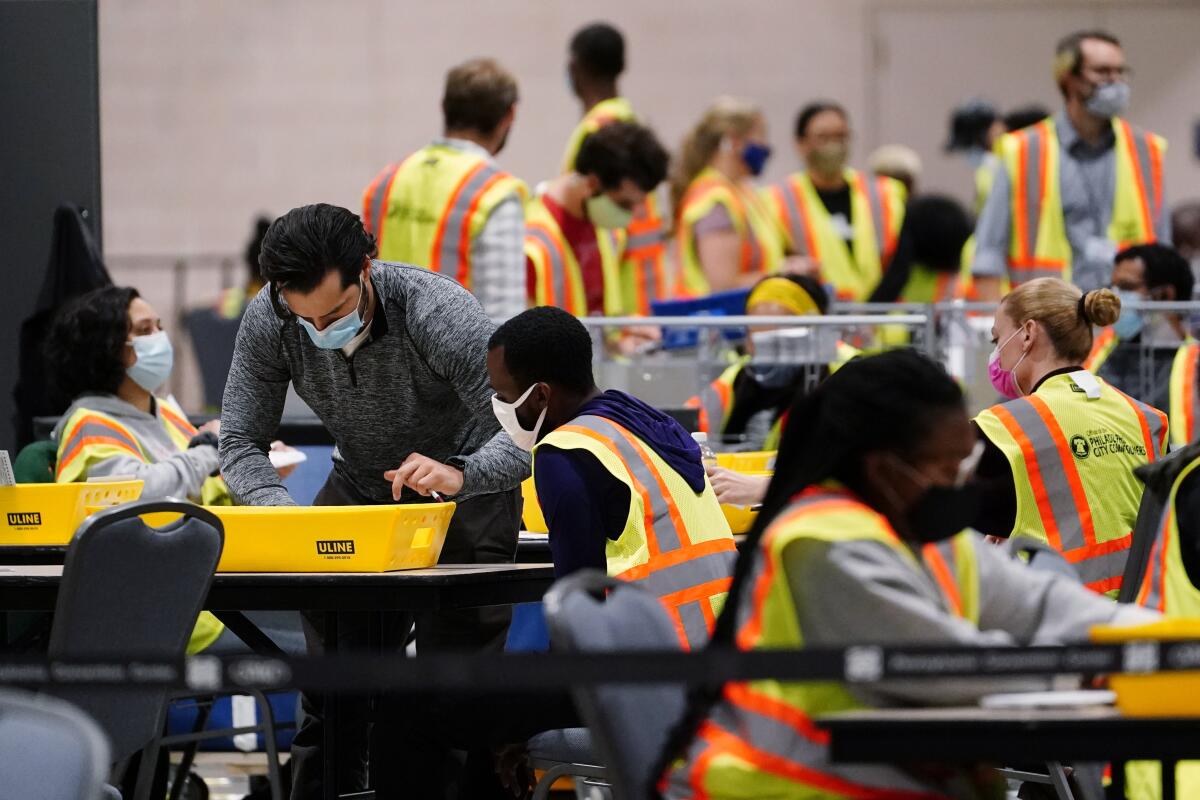News Analysis: No blue wave — or winner — as election outcome waits on a long count

- Share via
WASHINGTON — As the country settles in for a prolonged count to determine the winner of the 2020 election, this much is clear: Democratic hopes for a wave of votes that would sweep away barriers to progressive policy changes have suffered a significant setback.
Joe Biden continues to have a strong chance of winning the presidency by carrying the big industrial states of Pennsylvania, Michigan and Wisconsin, as well as Arizona, where he holds a strong lead. The party will also retain control of the House.
But in the final weeks of the campaign, favorable polls and a flood of campaign money had raised Democratic hopes of a significantly larger victory, one that would decisively repudiate the Trump-era Republican Party, expand Democrats’ House majority, give them clear control of the Senate and open the way to passage of long-stalled legislation on voting rights, climate change, immigration reform and other Democratic priorities.
Instead, the election results so far have proved the continued strength not only of President Trump, but of the country’s deeply entrenched partisan divide. Democratic hopes of a Senate majority dwindled through the night, raising the likelihood that even if he’s elected, Biden will face a divided Congress as well as a Supreme Court with a conservative majority that was strengthened last month with the confirmation of Justice Amy Coney Barrett.
Biden publicly expressed confidence Tuesday night while Trump accused Democrats and the media of trying to “disenfranchise” his supporters.
Trump, in a statement from the White House, said he would go to the Supreme Court to try to stop the vote count. “Frankly, we did win this election,” he said. “We want all voting to stop.”
Biden, in a briefing in Wilmington, Del., said, “We believe we’re on track to win,” reflecting the belief of his campaign officials that he will carry the three big industrial states, which are not likely to complete their vote counts until Thursday or perhaps later.
Georgia, too, will not be resolved until Wednesday at the earliest.
Other closely divided states could take even longer — North Carolina, for example, accepts mailed-in ballots up to nine days after the election so long as they are postmarked by election day. How many such ballots remain in the mail is not known.
Democratic strategists warned against over-interpreting the partial returns of an election that’s not yet complete.
In the 2018 midterm election, they noted, Democrats lost major races in Florida and Georgia only to end up winning 40 seats in the House, one of the largest gains in the modern era.
Trump accuses Democrats of trying to steal the election, making false claims
“It’s premature to say anything,” cautioned Democratic pollster Anna Greenberg. “It is entirely possible there will be a big popular vote win, and Trump would be the first one-term president in 28 years.”
“We shouldn’t judge the Democratic coalition based on Miami-Dade,” she added, pointing to the Florida county where the party suffered its biggest initial setback Tuesday.
While that may yet prove true, the prospect of continued legislative gridlock and the failure to achieve clear breakthroughs in the South were sobering for Democrats.
“I still think Biden wins, but it’s through the blue wall and Arizona, and not much else. Not the repudiation I was hoping for,” said Jim Kessler, executive vice president of Third Way, a centrist Democratic group.
The returns so far highlight weaknesses in the Democratic coalition.
The problem drawing the most attention as Tuesday’s results poured in was a deficit among Latino voters, which played a major role in Trump’s victory in Florida and in Democrats’ failure to achieve their long-desired goal of flipping Texas.
Those defeats are certain to prompt major debates among Democrats in the months to come, whether Biden wins or not.
“I think we’re all going to be reflecting quite a bit over the next few months — even if we manage to win at the top of the ticket,” said Jose Parra, a Democratic strategist who was a senior advisor to former Senate Majority Leader Harry Reid.
The exit poll conducted for a consortium of television networks indicated that Trump was winning about one-third of Latino voters nationwide, an improvement over his showing with the group in 2016.
Exit polls are far from a perfect measure, but at minimum, the results indicate Democrats have not made the progress they had hoped for with a fast-growing voter bloc.
Democratic weakness among Cuban American and other Latin American voters in south Florida not only powered Trump’s victory in the state, but also cost Democrats two Miami-area congressional districts.
As the presidential election nears, Democrats and Republicans are targeting Florida’s other Latino voters, not just Cuban Americans and Puerto Ricans.
Party strategists might be tempted to write the losses off as a one-time problem tied to Trump’s successful courtship of Cuban American voters, but Republican strength with Latino voters also played a major role in their victories in 2018 in the state’s elections for governor and the Senate.
Moreover, though Cuban Americans have long been a Republican-voting group, Democrats also came up short with Latino voters in Texas. Biden improved on Hillary Clinton’s showing in the suburbs outside Dallas and Houston, but fell significantly behind in the heavily Latino precincts of the Rio Grande Valley.
“Obviously the mantra that Latinos are not a monolith came to bear,” Parra said. “The results in Florida show that you have to make an effort to micro-target the different nationalities, different national origins.”
At the same time, Biden’s apparent win in Arizona stemmed in large part from Democratic gains among Latinos.
More Campaign 2020 coverage
All of that “shows you the stark contrast between south Florida Hispanics and Arizona Hispanics, or Hispanics in other parts of the country,” Parra said. “Again, it just shows you the vote is not homogeneous.”
Especially in Florida, Biden proved vulnerable to Trump’s accusations that he would put the country on the road to socialism — an attack that clearly hit a chord with Cuban American voters in particular. For Democrats, especially on the party’s energetic left, that was a dispiriting result.
If Biden wins, the power of those attacks will almost surely strengthen the arguments of those within his camp who have argued for moderation in the policies he advocates.
A Biden administration was always likely to feature tension between the party’s left and center. Now, if the final vote count does make Biden president, the nature of the victory will mean the progressives start out with a weakened hand.
Times staff writers Brittny Mejia in Las Vegas and Janet Hook in Washington contributed to this report.
More to Read
Get the L.A. Times Politics newsletter
Deeply reported insights into legislation, politics and policy from Sacramento, Washington and beyond. In your inbox three times per week.
You may occasionally receive promotional content from the Los Angeles Times.















